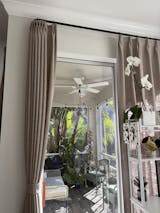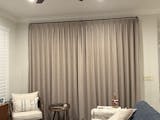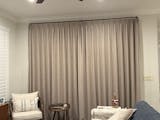How Eco-Friendly Considerations Shape a Green Home
By Lanada Chanel Duncan
Homeowners wanting to live more sustainably responsible while improving their quality of life, have come to rely heavily on eco-conscience design practices. This means they make intentional design choices that support their efforts to create environmentally friendly living spaces – aka “Green Homes.”

from: @classicstylehome
These well-thought-out choices for textiles, home appliances, fixtures, and other products come with so many advantages, which like a recycling wheel turns into benefit after benefit for the homeowner. Homeowners have seen their air quality and energy efficiency improved, as well as a boost in their overall wellbeing. And let us not forget the money savings.
Furthermore, a family can live more comfortably and cozy in their home knowing their design choices are improving their health and the planet, simultaneously.
Yet, the consideration that must be given when selecting eco-friendly home products comes down to knowing what will support a family’s lifestyle, the functionality of their living spaces, and have a significant environmental impact. Every decision, good or bad, plays a role in shaping a Greene home.
These are key home design areas and items where thoughtful consideration could help make decisions with lasting benefits.
Energy-Efficient Lighting, Appliances, and Window Treatments
- With lighting now considered the “jewelry of the home,” it has become one of the most pondered over items homeowners dwell on in their sustainable home design selection. With so many lighting design styles to select from, this sometimes adds to selection delays. However, when we consider Energy-Efficient Lighting, we should remember that most LED lights use at least 90% less energy and last longer than traditional light fixtures. Therefore, integrating LED lighting into areas of your home could save you a good amount of time (not having to change out bulbs) and money (less bulbs to purchase). Lastly, optimize your lighting by placing it on an automation system that uses less energy and allows your lights to function around your family’s active moments and daily behaviors.
- What is a Green Home without Energy-Efficient Appliances - not a Green Home! As the most powered / energy pieces of your home, your appliances are essential to making your home sustainable. While conventional homes tend to have appliances that significantly contribute to greenhouse gas emissions, which pollutes the air, they also consume more energy and cost homeowners more overall. On the other hand, sustainable homes contain appliances that use less water, less energy, and have a longer lifespan because these appliances are made with better quality materials. “Energy Star” is a government certified energy efficient appliance often purchased for sustainable home use.
- Home products that can function as Energy Regulators, like window treatments, can be extremely useful towards helping to control indoor temperatures. When air escapes through your windows and enters your home, it takes more energy to warm or cool your living spaces. Additionally, solar heat from excess sunlight coming through windows can also create the need for more energy to stabilize the temperature in your home. Light filtering curtains, window shades, and adjustable blinds serve as buffers that can prevent and reduce the amount of air or heat escaping into or out of your home. TWOPAGES Curtains offers amazing Bamboo woven shades, linen cotton drapes, and blackout curtains that function very well as energy regulators.

from: @homestylebypaula
Sustainable Materials for Home Décor
Green Home homeowners look for ways to use more materials and products that are either recycled, non-toxic, durable, or locally sourced because they contribute to healthier living environments.
- When materials and products are labeled and considered Low VOC, this means they have less volatile organic compounds in them. These compounds contain substances that, when evaporated, form vapors and gases that are potentially harmful if released into the environment because they have potential for causing severe health problems. Low VOC products (paints, flooring, furniture) are great options for keeping a home toxic-free. There are third party environmental safety organizations that certify products for their non-toxic value – Greenguard, Global Organic Textile Standard (GOTS), and OEKO-TEX. For items without sustainable certification, it is always best to leave new furniture pieces, freshly painted or wallpapered walls, or newly installed flooring exposed in a well-ventilated area several days before using.
- Also playing a key role in a sustainable home are recycled materials, reclaimed wood, and organic textiles. These kinds of items often have a longer shelf life and can be more durable. Because they have sustainability built into their fabric and makeup, they can also come at a higher cost, so make sure it suits your long-term needs and goes with your style and function of the space before you put forth the investment.
- Not only is using recycling products great for sustainable living but recycling dollars into the community and opting for locally source products, skilled artists, and tradesmen to use in your home design reduces carbon emissions and supports low carbon neutral footprints.
Water Conservation and Biophilic Design
- Incorporating the right water conservation products can be the wisest plumbing choice you make if you are creating a Green Home. Having low-flow faucets, dual-flush toilets, and smart irrigation systems will help you reduce the amount of water flow in your home without compromising water pressure. They will also lessen the amount of energy it takes to produce hot water - all leading to money savings.
- One of the best, increasingly popular ways to improve your environment indoors is with biophilic design like houseplants and the use of more natural materials. While plants not only improve the air quality by absorbing toxins and increasing oxygen, but they also help a space look beautiful, boost moods, improves focus ability, and create calming atmospheres. Air purifying plants like Snake plants and Pathos are great to start off with if you want something that is minimal maintenance. Like plants, furnishings and other design elements made of natural materials like marble, soapstone, and bamboo are taking center stage in sustainable homes because their connectedness to nature appeals to homeowners helping them feel more connected to the environment.

from: @whitcomb_home
In conclusion, planning purchases, starting small, and being consistent are the most important steps for creating a Green Home. Sustainable living is a marathon process, not a race. Starting with items like lighting, plants, and window treatments gives you the encouragement you need to keep applying eco-friendly products to other areas of your home. Enjoy exploring processes and products that will help you slowly transition your home into a fully operating Green Home and be confident knowing you are on your way to wellness and having a positive impact on your environment.
For more eco-friendly design ideas for your home, reach out to b.e. decors Interiors and schedule a complimentary design consultation.




























Leave a comment